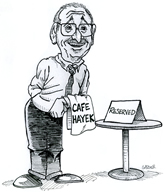Brian Albrecht, Geoff Manne, David Teece, and Mario Zúñiga trace the development of the semiconductor industry. Here’s the abstract:
The semiconductor manufacturing industry exhibits unique competitive dynamics driven by Moore’s Law and Rock’s Law, which together impose exponentially increasing technological requirements and capital costs. These twin forces produce recurring “competitions for the market” rather than conventional price-based rivalry, with firms competing through massive preemptive investments in successive technology generations. In this environment, apparent market concentration and complex interfirm relationships likely reflect efficient organizational responses to extreme capital requirements and technological uncertainty. High returns in this industry typically represent Ricardian and Schumpeterian rents from innovation rather than monopoly profits. Standard antitrust metrics may mischaracterize competition in industries where technological discontinuities periodically reset market positions and where success depends on dynamic capabilities rather than static efficiency.
Green engages in a series of calculations that would earn a D in my master’s class. He concludes: “So when I say the real poverty line is $140,000, I’m being conservative.” Of course, poverty thresholds are inherently arbitrary. You’re free to argue that three-quarters of households are living in poverty — but that argument is absurd on its face.
Why? Because any poverty threshold that finds most households living in poverty is not analytically serious or practicable. The economist Ernie Tedeschi computes that around 75 percent of households earn less than $140,000. Moreover, as Tedeschi shows, if that’s your threshold, then you should be feeling good about the nation’s progress!
…..
The social scientist Scott Winship did the heroic work of replicating Green’s calculation. Winship shows that applying more reasonable data to Green’s equation can compute a poverty threshold as low as $24,470, far lower than Green’s choice of $140,000.
…..
Analysis by the economists Richard V. Burkhauser, Kevin Corinth, James Elwell, and Jeff Larrimore shows that poverty fell much further when broader definitions of income were used and when inflation was more accurately measured, falling from nearly 20 percent in 1963 to below 4 percent in 2019.
Standard economic analysis suggests that we should care more about consumption poverty than income poverty. The team of economists finds that consumption poverty fell from above 30 percent in the early 1960s to 2 percent in 2019.
…..
Tens of thousands of years ago, an approaching predator could end our lives. Perhaps because of that, we are hardwired to place greater psychological weight on risk than on safety. This may be why bad news sells and headlines never read “Airplane Lands Safely.”
But planes land safely every day. And the American dream is not dead — no matter how often low-quality analysis “demonstrates” that it is.
When Americans think about their refrigerator and other appliances, they shouldn’t think, “Economics is fake.” Instead, they should recognize that this is one area of their consumption that has become more affordable, thanks to globalization and other competitive forces, whereas housing, healthcare, and education have become less affordable. And while those services are an important part of the typical household budget, the story of increasing affordability for refrigerators is in no way unique for goods produced under a free market economy. Despite claims of economic stagnation since the 1970s, Marian Tupy has shown that finished goods have become increasingly abundant relative to wages since 1971.
While the long-term trends in the affordability of finished goods are favorable for consumers, there is one recent factor pushing in the opposite direction: tariffs. For example, a paper published in the American Economic Review showed that the 2018 tariffs on washing machines increased prices by about 12 percent. And while Figure 2 above showed increasing affordability of appliance prices, if we zoom in on the most recent years, the trends have started shifting in the wrong direction again after the much broader 2025 tariffs were imposed. Figure 3 shows that, after rising in tandem with almost everything else during the pandemic, appliance prices began to fall in 2022 and continued to decline through 2024, but then reversed in 2025. While the increase since March 2025 (before the biggest tariff announcements) has been somewhat small, it would have been much larger if we had expected the pre-2025 trend to continue.
“If the guy who promised you lower prices then suddenly promises to raise prices and prices go up, well, guess what? That guy is going to get blamed,” @scottlincicome told @FoxNews about voters’ disapproval of President Trump’s handling of the economy.



